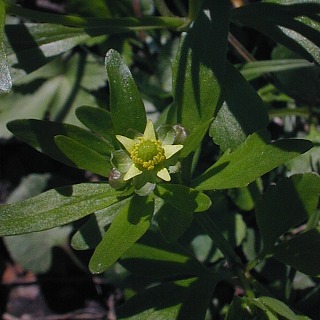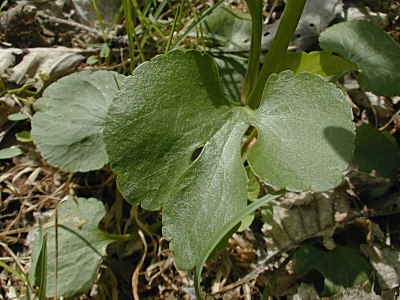Description:
This
herbaceous plant is a biennial or short-lived perennial up to 2' tall
that
branches occasionally. The green stems are glabrous. The blades of the
basal leaves are up to 2" long and 2½" across; they are
orbicular-reniform and crenate along the margins. Their petioles are up
to 3" long. The lower cauline leaves are up to 2" long and across on
petioles up to 1" long; they are often deeply divided into 3 rounded
lobes and their margins are crenate. The upper cauline leaves are
usually lanceolate, oblanceolate, or oblong with smooth margins; sometimes
they are shallowly lobed with teeth that are crenate or dentate. The
blades of the upper cauline leaves are up to 1½" long and they are
sessile. All of these leaves are hairless; the cauline leaves alternate
along the stems. Each upper stem terminates in 1-3 flowers on
individual stalks. Each flower is about ¼" across, consisting of 5
yellow petals, 5 green sepals, a cluster of green carpels, and a ring
of stamens with bright yellow anthers. The petals are broadly
lanceolate or triangular; they are smaller than the sepals. The sepals
become membranous with age and they fall off the flower at about the
same time as the petals. The blooming period occurs from mid-spring to
early summer and lasts about 1-2 months. The cluster of carpels
(immature achenes) elongates to about ¼" in length and becomes ovoid in
shape. The small achenes are somewhat flattened and orbicular in shape;
their surfaces are shiny when mature and they have very small beaks.
The root system consists of a tuft of fibrous roots. This plant spreads
by reseeding itself.
smooth margins; sometimes
they are shallowly lobed with teeth that are crenate or dentate. The
blades of the upper cauline leaves are up to 1½" long and they are
sessile. All of these leaves are hairless; the cauline leaves alternate
along the stems. Each upper stem terminates in 1-3 flowers on
individual stalks. Each flower is about ¼" across, consisting of 5
yellow petals, 5 green sepals, a cluster of green carpels, and a ring
of stamens with bright yellow anthers. The petals are broadly
lanceolate or triangular; they are smaller than the sepals. The sepals
become membranous with age and they fall off the flower at about the
same time as the petals. The blooming period occurs from mid-spring to
early summer and lasts about 1-2 months. The cluster of carpels
(immature achenes) elongates to about ¼" in length and becomes ovoid in
shape. The small achenes are somewhat flattened and orbicular in shape;
their surfaces are shiny when mature and they have very small beaks.
The root system consists of a tuft of fibrous roots. This plant spreads
by reseeding itself.
Cultivation:
This plant is typically found in partial sunlight, moist to mesic
conditions, and a reasonably fertile loam or clay-loam soil. It has few
problems with pests and disease.
Range & Habitat:
Small-Flowered Buttercup is a common native plant that has been
observed in
nearly all counties of Illinois (see Distribution
Map); it probably occurs in the remaining counties as well.
Habitats include open woodlands, woodland borders, areas along woodland
paths, degraded meadows, banks of rivers and ditches, pastures and
abandoned fields, edges of yards, vacant lots, grassy areas along
railroads and roads, and waste areas. This plant is typically found in
disturbed areas and is somewhat weedy.
Faunal Associations:
Ladybird beetles, small bees, Syrphid flies, and other kinds of flies
suck nectar from the flowers. Some flies and ladybird beetles feed on
the pollen, while some bees collect pollen for their larvae. Ants suck
nectar that adheres to the carpels after the petals and sepals fall of
the flowers. The Wood Duck and Wild Turkey eat the foliage and seeds of
Ranunculus spp. (Buttercups). Some small rodents,
including the Eastern Chipmunk and Meadow Vole, eat the seeds, while
the Cottontail Rabbit eats the foliage. However, the use of the foliage
and seeds as a food source by these animals is rather limited. The
foliage contains a blistering agent and is mildly toxic to livestock.

Photographic
Location: The
upper photograph was taken at the edge of a yard in Urbana, Illinois,
while the lower photograph was taken of a plant growing along a
woodland border in the same city.
Comments:
Small-Flowered Buttercup is one of the most common Ranunculus
spp. in Illinois. The flowers aren't very showy and this
plant is easily overlooked. There are many Ranunculus spp.
in the state and they are often hard to tell apart. While attempting to
identify Small-Flowered Buttercup, look for lower leaves that are
orbicular, kidney-shaped, or deeply 3-lobed with crenate margins, and
slender upper leaves with mostly smooth margins. The foliage is usually
hairless, although there is an uncommon form of this plant that is
finely pubescent. Small-Flowered Buttercup is very similar in
appearance to Ranunculus micranthus (also called
Small-Flowered Buttercup); the latter species is restricted to the
southern half of Illinois. To distinguish Ranunculus abortivus
from Ranunculus micranthus, it is often necessary
to examine the naked receptacles of these two species (the receptacle
of the flower is what remains after the carpels, sepals, and petals are
removed). The receptacle of Ranunculus abortivus is
pubescent, while the receptacle of Ranunculus micranthus
is hairless. Another difference is the following: the achenes of Ranunculus
abortivus have a shiny surface, while the achenes of Ranunculus
micranthus have a dull surface.